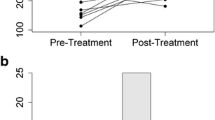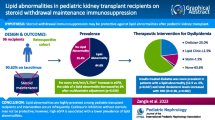Abstract
Background: HMG-CoA reductase inhibitors (statins) have effects beyond lipid lowering, including immunomodulatory and anti-inflammatory properties. Statins are frequently combined with immunosuppressive agents in transplant recipients to modulate the hyperlipidemic side effects of the immunosuppressants. However, the role of statins in the immunosuppressive response that is achieved in individual patients remains to be assessed.
Objective: The aim of this study was to evaluate the immunomodulatory effect of atorvastatin given alone and in combined treatment with tacrolimus and mycophenolate mofetil.
Study Design: Two patient groups were studied: renal transplant recipients receiving tacrolimus and mycophenolate mofetil therapy, and hypercholesterolemic patients (the control group). Fasting blood samples were taken from participants before and 1 month after atorvastatin treatment was started to study a small battery of biomarkers that are able to reflect the range of the effects of immunosuppressive therapy and atorvastatin.
Setting: All patients in the study were enrolled at the Hospital Clinic of Barcelona.
Patients: All patients enrolled in the study were candidates for treatment with atorvastatin because of high cholesterol levels. One group consisted of 25 stable renal transplant recipients with low-density lipoprotein (LDL) cholesterol levels above 100mg/dL after 3 months of therapeutic lifestyle changes, according to the guidelines of the National Kidney Foundation —Kidney Disease Outcomes Quality Initiative. The other group included 25 hypercholesterolemic patients with LDL cholesterol levels above target values for the patients’ overall risk, as derived from the National Cholesterol Education Program Adult Treatment Panel III criteria.
Intervention: Atorvastatin (Lipitor®) treatment was started at a fixed dose of 20 mg daily.
Main Outcome Measure: The studied biomarkers were lymphocyte proliferation, intracellular adenosine triphosphate (ATP) synthesis in CD4+ T cells, intralymphocytary cytokine expression (interleukin [IL]-2, interferon [IFN]-γ), soluble cytokine production (IL-2, IFN-γ, IL-10, IL-17, and transforming growth factor-β) and regulatory T (Treg) cells.
Results: Atorvastatin proved to be an immunomodulatory agent, significantly decreasing lymphocyte proliferation by 15% (p = 0.001), increasing ATP levels by 16% (p = 0.0004), and showing a trend toward increasing Treg cells in hypercholesterolemic patients (p = 0.09). In the renal transplant recipients, atorvastatin therapy did not modify any of the biomarkers of immunosuppression that were studied.
Conclusion: Atorvastatin showed immunoregulatory effects on T cells in hypercholesterolemic patients. These effects were absent in renal transplant recipients, suggesting that the beneficial effects of atorvastatin in this patient group do not relate to immunoregulation. Therefore, statin treatment cannot be considered as a means to reduce the dose of immunosuppressive agents.





Similar content being viewed by others
References
Jacobson JR. Statins in endothelial signaling and activation. Antioxid Redox Signal 2009; 11(4): 811–21
Greenwood J, Mason JC. Statins and the vascular endothelial inflammatory response. Trends Immunol 2007; 28(2): 88–98
Greenwood J, Steinman L, Zamvil SS. Statin therapy and autoimmune disease: from protein prenylation to immunomodulation. Nat Rev Immunol 2006; 6(5): 358–7
Arnaud C, Braunersreuther V, Mach F. Toward immunomodulatory and anti-inflammatory properties of statins. Trends Cardiovasc Med 2005; 15(6): 202–6
Wang CY, Liu PY, Liao JK. Pleiotropic effects of statin therapy: molecular mechanisms and clinical results. Trends Mol Med 2008; 14(1): 37–44
Shimada K, Park JK, Daida H. T helper 1/T helper 2 balance and HMG-CoA reductase inhibitors in acute coronary syndrome: statins as immunomodulatory agents? Eur Heart J 2006; 27(24): 2916–8
Arnaud C, Veillard NR, Mach F. Cholesterol-independent effects of statins in inflammation, immunomodulation and atherosclerosis. Curr Drug Targets Cardiovasc Haematol Disord 2005; 5(2): 127–34
Mach F. Statins as immunomodulators. Transpl Immunol 2002; 9(2–4): 197–20
Kuipers HF, Biesta PJ, Groothuis TA, et al. Statins affect cell-surface expression of major histocompatibility complex class II molecules by disrupting cholesterol-containing microdomains. Hum Immunol 2005; 66(6): 653–65
Weitz-Schmidt G, Welzenbach K, Brinkmann V, et al. Statins selectively inhibit leukocyte function antigen-1 by binding to a novel regulatory integrin site. Nat Med 2001; 7(6): 687–92
Chow SC. Immunomodulation by statins: mechanisms and potential impact on autoimmune diseases. Arch Immunol Ther Exp (Warsz) 2009; 57(4): 243–51
Schonbeck U, Libby P. Inflammation, immunity, and HMG-CoA reductase inhibitors: statins as antiinflammatory agents? Circulation 2004; 109(21 Suppl. 1): II18–26
McMahon M, Brahn E. Inflammatory lipids as a target for therapy in the rheumatic diseases. Expert Opin Investig Drugs 2008; 17(8): 1213–24
McKay A, Leung BP, McInnes IB, et al. A novel anti-inflammatory role of simvastatin in a murine model of allergic asthma. J Immunol 2004; 172(5): 2903–8
Youssef S, Stuve O, Patarroyo JC, et al. The HMG-CoA reductase inhibitor, atorvastatin, promotes a Th2 bias and reverses paralysis in central nervous system autoimmune disease. Nature 2002; 420(6911): 78–84
Graham KL, Lee LY, Higgins JP, et al. Failure of oral atorvastatin to modulate a murine model of systemic lupus erythematosus. Arthritis Rheum 2008; 58(7): 2098–104
Navaneethan SD, Perkovic V, Johnson DW, et al. HMG CoA reductase inhibitors (statins) for kidney transplant recipients. Cochrane Database Syst Rev 2009; (2): CD005019
Jardine AG, Fellstrom B, Logan JO, et al. Cardiovascular risk and renal transplantation: post hoc analyses of the Assessment of Lescol in Renal Transplantation (ALERT) study. Am J Kidney Dis 2005; 46(3): 529–36
Holdaas H, Fellstrom B, Jardine AG, et al. Effect of fluvastatin on cardiac outcomes in renal transplant recipients: a multicentre, randomised, placebo-controlled trial. Lancet 2003; 361(9374): 2024–31
Patel J, Kobashigawa JA. Minimization of immunosuppression: transplant immunology. Transpl Immunol 2008; 20(1-2): 48–54
Yabu JM, Vincenti F. Kidney transplantation: the ideal immunosuppression regimen. Adv Chronic Kidney Dis 2009; 16(4): 226–33
Farkas SA, Schnitzbauer AA, Kirchner G, et al. Calcineurin inhibitor minimization protocols in liver transplantation. Transpl Int 2009; 22(1): 49–6
Lerut J, Bonaccorsi-Riani E, Finet P, et al. Minimization of steroids in liver transplantation. Transpl Int 2009; 22(1): 2–19
Nie C, Yang D, Liu G, et al. Statins induce immunosuppressive effect on heterotopic limb allografts in rat through inhibiting T cell activation and proliferation. Eur J Pharmacol 2009; 602(1): 168–75
Bessler H, Salman H, Bergman M, et al. In vitro effect of statins on cytokine production and mitogen response of human peripheral blood mononuclear cells. Clin Immunol 2005; 117(1): 73–7
Takahashi HK, Iwagaki H, Yagi T, et al. Action profiles of statins and calcineurin inhibitors during human mixed lymphocyte reaction. Clin Immunol 2007; 123(3): 324–32
Barten MJ, van GT, Gummert JF, et al. Pharmacodynamics of mycophenolate mofetil after heart transplantation: new mechanisms of action and correlations with histologic severity of graft rejection. Am J Transplant 2002; 2(8): 719–32
Millán O, Brunet M, Campistol JM, et al. Pharmacodynamic approach to immunosuppressive therapies using calcineurin inhibitors and mycophenolate mofetil. Clin Chem 2003; 49(11): 1891–9
Grinyo JM, Ekberg H, Mamelok RD, et al. The pharmacokinetics of mycophenolate mofetil in renal transplant recipients receiving standard-dose or low-dose cyclosporine, low-dose tacrolimus or low-dose sirolimus: the SYMPHONY pharmacokinetic substudy. Nephrol Dial Transplant 2009; 24(7): 2269–76
Brunet M, Campistol JM, Diekmann F, et al. T-cell function monitoring in stable renal transplant patients treated with sirolimus monotherapy. Mol Diagn Ther 2007; 11(4): 247–56
Kasiske B, Cosio FG, Beto J, et al. Clinical practice guidelines for managing dyslipidemias in kidney transplant patients: a report from the Managing Dyslipidemias in Chronic Kidney Disease Work Group of the National Kidney Foundation Kidney Disease Outcomes Quality Initiative. Am J Transplant 2004; 4Suppl. 7: 13–53
Expert Panel on Detection, Evaluation, and Treatment of High Blood Cholesterol in Adults. Executive summary of the third report of the National Cholesterol Education Program (NCEP) Expert Panel on Detection, Evaluation, and Treatment of High Blood Cholesterol in Adults (Adult Treatment Panel III). JAMA 2001; 285(19): 2486–97
Streit F, Armstrong VW, Oellerich M. Rapid liquid chromatography-tandem mass spectrometry routine method for simultaneous determination of sirolimus, everolimus, tacrolimus, and cyclosporin A in whole blood. Clin Chem 2002; 48 (6 Pt 1): 955–8
Brunet M, Cirera I, Martorell J, et al. Sequential determination of pharmacokinetics and pharmacodynamics of mycophenolic acid in liver transplant patients treated with mycophenolate mofetil. Transplantation 2006; 81(4): 541–6
Guillén D, Cofán F, Ros E, et al. Determination of atorvastatin and its metabolite ortho-hydroxyatorvastatin in human plasma by on-line anion-exchange solid-phase extraction and liquid chromatography tandem mass spectrometry. Anal Bioanal Chem 2009; 394(6): 1687–96
Godoy-Ramirez K, Franck K, Mahdavifar S, et al. Optimum culture conditions for specific and nonspecific activation of whole blood and PBMC for intracellular cytokine assessment by flow cytometry. J Immunol Methods 2004; 292(1–2): 1–15
Katznelson S, Wilkinson AH, Kobashigawa JA, et al. The effect of pravastatin on acute rejection after kidney transplantation: a pilot study. Transplantation 1996; 61(10): 1469–74
Tuncer M, Suleymanlar G, Ersoy FF, et al. Comparison of the effects of simvastatin and pravastatin on acute rejection episodes in renal transplant patients. Transplant Proc 2010; 32(3): 622–5
Kasiske BL, Heim-Duthoy KL, Singer GG, et al. The effects of lipid-lowering agents on acute renal allograft rejection. Transplantation 2001; 72(2): 223–7
Sahu K, Sharma R, Gupta A, et al. Effect of lovastatin, an HMG CoA reductase inhibitor, on acute renal allograft rejection. Clin Transplant 2001; 15(3): 173–5
Kantola T, Kivisto KT, Neuvonen PJ. Effect of itraconazole on the pharmacokinetics of atorvastatin. Clin Pharmacol Ther 1998; 64(1): 58–65
Hermann M, Christensen H, Reubsaet JL. Determination of atorvastatin and metabolites in human plasma with solid-phase extraction followed by LC-tandem MS. Anal Bioanal Chem 2005; 382(5): 1242–9
Hermann M, Asberg A, Christensen H, et al. Substantially elevated levels of atorvastatin and metabolites in cyclosporine-treated renal transplant recipients. Clin Pharmacol Ther 2004; 76(4): 388–91
Stern RH, Yang BB, Horton M, et al. Renal dysfunction does not alter the pharmacokinetics or LDL-cholesterol reduction of atorvastatin. J Clin Pharmacol 1997; 37(9): 816–9
Kowalski RJ, Post DR, Mannon RB, et al. Assessing relative risks of infection and rejection: a meta-analysis using an immune function assay. Transplantation 2006; 82(5): 663–8
Millán O, Sanchez-Fueyo A, Rimola A, et al. Is the intracellular ATP concentration of CD4+ T-cells a predictive biomarker of immune status in stable transplant recipients? Transplantation 2009; 88(3 Suppl.): S78–84
Bhorade SM, Janata K, Vigneswaran WT, et al. Cylex ImmuKnow assay levels are lower in lung transplant recipients with infection. J Heart Lung Transplant 2008; 27(9): 990–4
Rossano JW, Denfield SW, Kim JJ, et al. Assessment of the Cylex ImmuKnow cell function assay in pediatric heart transplant patients. J Heart Lung Transplant 2009; 28(1): 26–31
Husain S, Raza K, Pilewski JM, et al. Experience with immune monitoring in lung transplant recipients: correlation of low immune function with infection. Transplantation 2009; 87(12): 1852–7
Macedo C, Zeevi A, Bentlejewski C, et al. The impact of EBV load on T-cell immunity in pediatric thoracic transplant recipients. Transplantation 2009; 88(1): 123–8
Boleslawski E, Conti F, Sanquer S, et al. Defective inhibition of peripheral CD8+ T cell IL-2 production by anti-calcineurin drugs during acute liver allograft rejection. Transplantation 2004; 77(12): 1815–2
Cherfan P, Tompa A, Wikby A, et al. Effects of simvastatin on human T cells in vivo. Atherosclerosis 2007; 193(1): 186–92
Mausner-Fainberg K, Luboshits G, Mor A, et al. The effect of HMG-CoA reductase inhibitors on naturally occurring CD4+CD25+ T cells. Atherosclerosis 2008; 197(2): 829–39
Acknowledgments
This study was partially supported by a grant from the “Institut d’Investigacions Biomièdiques August Pi i Sunyer” (IDIBAPS) awarded to David Guillén and by a grant from the “Fundación)n de Investigación Médica Mutua Madrilena” awarded to Olga Millán. The authors’ work was independent of the funders. CIBERehd and CIBERobn are initiatives of ISCIII, Spain. The authors declare no conflict of interest. Research design: Mercè Brunet. Writing of the paper: David Guillén, Federico Cofán, Emilio Ros, Mercè Brunet. Performance of the research: David Guillén, Federico Cofán, Emilio Ros, Olga Millám, Montse Cofán. Data collection: David Guillén, Federico Cofán, Emilio Ros, Montse Cofán. Data analysis: David Guillén, Olga Millán, Mercè Brunet.
Author information
Authors and Affiliations
Corresponding author
Rights and permissions
About this article
Cite this article
Guillén, D., Cofán, F., Ros, E. et al. Biomarker Assessment of the Immunomodulator Effect of Atorvastatin in Stable Renal Transplant Recipients and Hypercholesterolemic Patients. Mol Diag Ther 14, 357–366 (2010). https://doi.org/10.1007/BF03256393
Published:
Issue Date:
DOI: https://doi.org/10.1007/BF03256393




